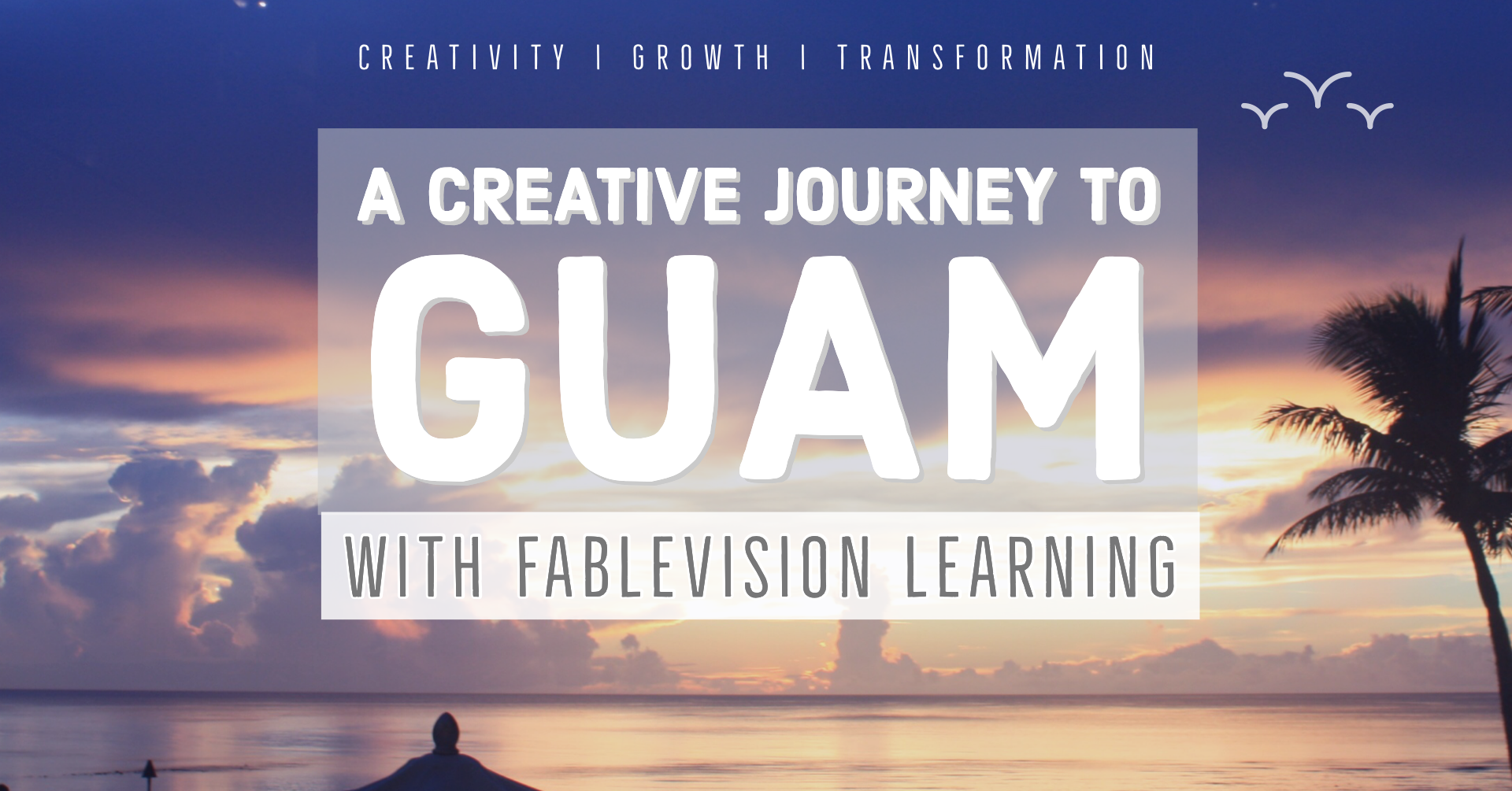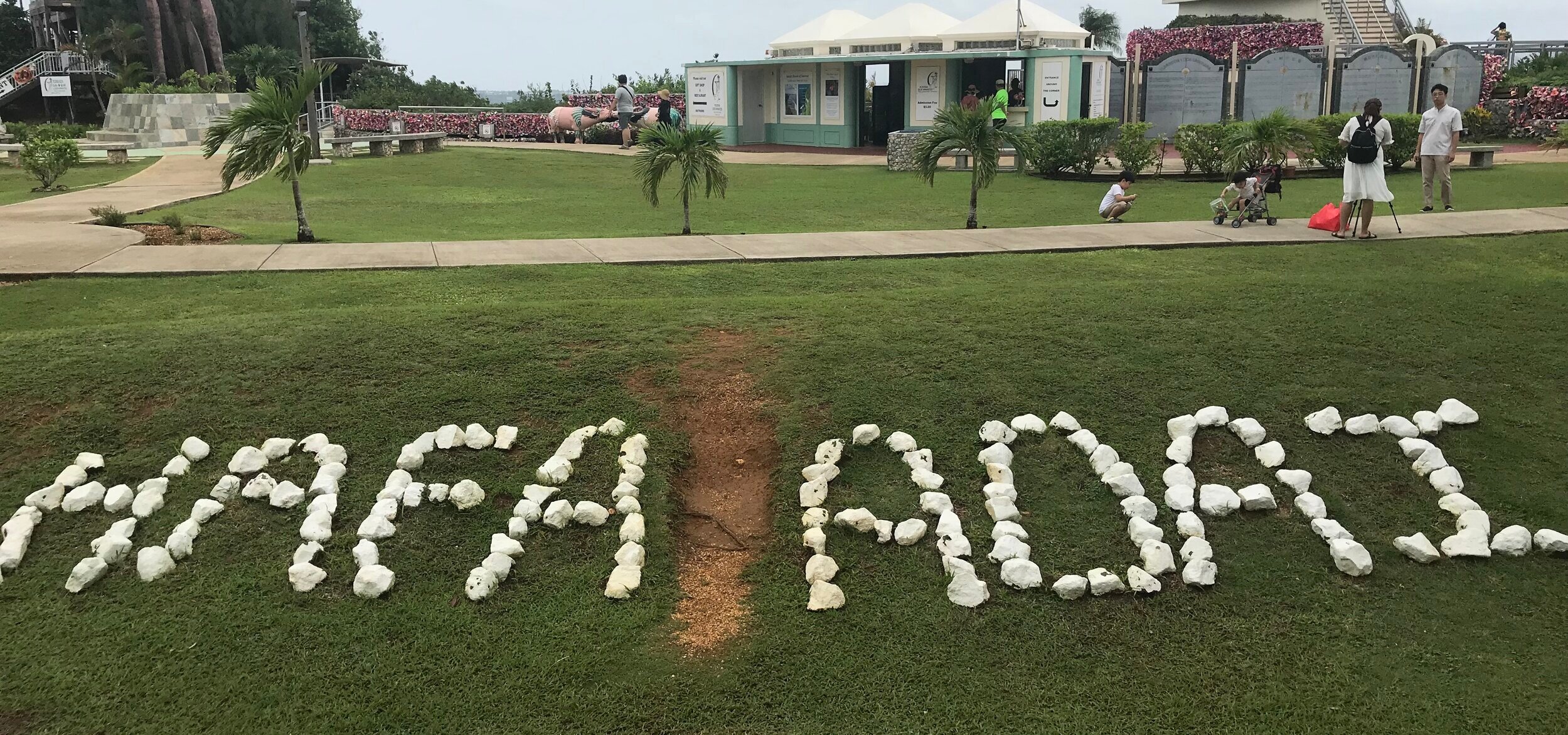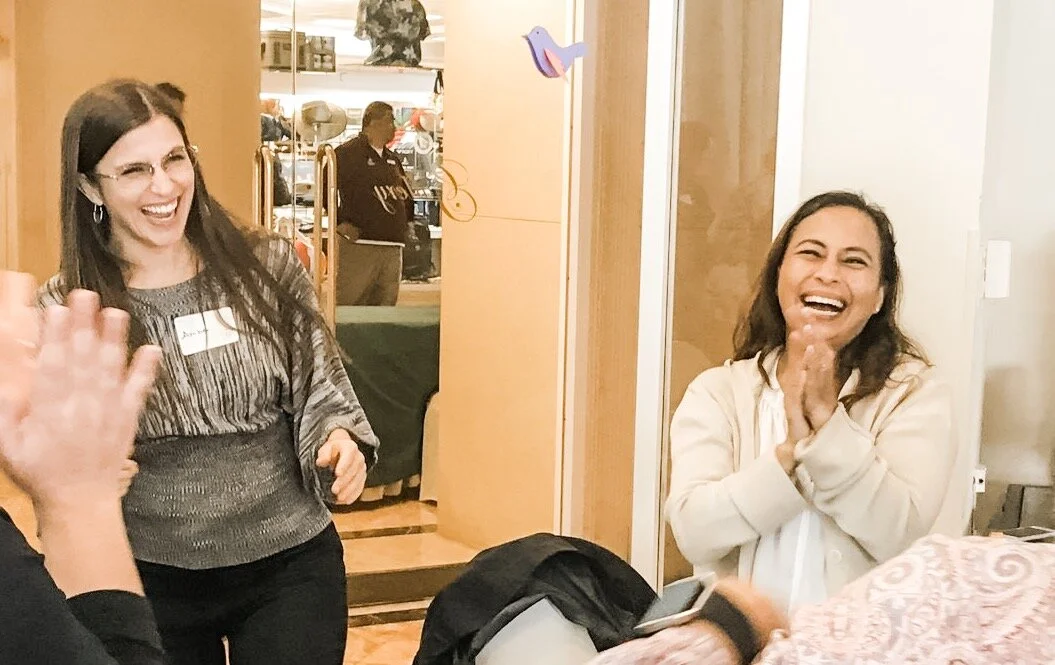A Creative Journey to Guam
This September, the team at FableVision Learning had the pleasure of spending a week exploring creativity with the GATE Gifted and Talented Educators from across the island of Guam.
This September, the team at FableVision Learning had the pleasure of spending a week exploring creativity with the GATE Gifted and Talented Educators from across the island of Guam. It was such an amazing experience!
Hafa Adai means “hello” in Guam’s native language, Chamorro
We brought them our newest workshop on creative teaching and learning, and they brought us the generous and kind Hafa Adai spirit (Hafa Adai means “hello” in Guam’s native language, Chamorro).
We were lucky enough to begin our week on International Dot Day. Our founder, New York Times best-selling author/illustrator Peter H. Reynolds, joined the room virtually, and shared his inspiring story, hopes, and appreciation.
Then, we celebrated! The teachers loved creating their own dots, and learning ways to incorporate the A in STEAM (Science, Technology, Engineering, Arts, and Math).
But, of course, art was merely the first step in our creative journey, as teachers discovered how creativity powers innovation and invention.
For the rest of the week, we dove into the science of creative thinking.
Peter H. Reynold and Paul Reynolds both joined the program virtually
We discussed a creative education framework and creative learning model. We used Peter’s picture books to practice creativity skills. We shared ideas and explored creative problem solving. We even created our own creative classroom climate checklist together, based on research.
And all throughout, we had a blast! There were games, songs, and lots and lots of laughs.
The teachers also got to explore our Creativity Maker Suite programs for students - Fab@School Maker Studio, Animation-ish, and Get Published - and ended the five-day program with a virtual chat (from 8,000 miles away!) with FableVision's CEO Paul Reynolds.
In Guam, we enjoyed games, songs, challenges, and many laughs!
By the end of the week, the teachers were full of excitement, ideas, plans, and the motivation to create bravely with their students.
Seeing these teachers alight with new ideas gave us so much excitement for the future of creative education.
All it takes are teachers who are willing to make their classrooms havens of creativity - teachers who will lead the charge in making change. We are grateful to have been a part of their journey.
We already have plans to visit Guam again soon, and can’t wait to continue to light the path of creative learning and action with other schools around the world.
To learn more about our creativity programs and training, contact info@fablevisionlearning.com
ABOUT THE AUTHOR:
Sara Smith is Creative Education Development Manager for FableVision Learning. She holds a Master of Science in creativity from the International Center for Studies in Creativity at SUNY College at Buffalo. Sara is compelled by learning and its intersection with creativity, and her vision is to develop and support creative communities that help people to grow and to nurture their passions and strengths.
On April 6, 2019, FableVision and the American University Game Lab will co-host a FREE CONFERENCE in Washington, DC, exploring Libraries, Games, and Play.
(Register and/or apply for a travel stipend by March 15, 2019!)
Learn more, and get some fun ideas and resources for custom dice + imaginative games!
On April 6, 2019, FableVision and the American University Game Lab will co-host a FREE conference in Washington, DC, exploring Libraries, Games, and Play.
FableVision/Reynolds Center co-founder and CEO Paul Reynolds will provide the closing keynote, celebrating librarians and creative educators who are providing no-tech, low-tech and high-tech tools and programs that support creativity and playful learning.
Reynolds notes that the role of librarians is especially important in light of the increasingly digital landscape that has resulted in seismic shifts in both the functions and offerings of physical libraries.
“Today’s librarians are bravely embracing technological change, as they offer exciting new portals into playful learning, and cultivate critical, future-proofing skills - such as communication, collaboration, critical thinking and creativity,” says Reynolds.
Librarians are creating innovative learning environments through the curation of digital resources and play-based learning, as well as scaffolding constructionist learning opportunities – including maker-space activities and game development.
Try It Out in Your Classroom, or at Home!
To celebrate Libraries, Games, and Play, we used Fab@School Maker Studio to create custom cardstock dice (see a tutorial for storytelling dice here). You can also experiment with other geometric forms, decks of cards, or even traditional dice sets.
For older children, two or more custom dice could be combined for:
mythical-creature drawing challenges (one of the dice shows the head, one dictates the body, and one the magical power),
improvisational role play,
rhyming, poetry, and song games,
hand-drawn board games to the theme of a child’s choosing, and so on.
Click here to download a FREE template of the printable shown on the below, which can be used with students to design games that fit into your curriculum!
When building games with students, you can keep it simple with a favorite literary theme; or, you can:
add in artistic or musical tasks,
make skip-ahead squares, reverse components, or one-one-on challenges if two players land on the same space,
add in coding-themed tasks,
cut, paste, and reconfigure on a larger board,
and tie it in to other classroom learning!
These types of games — highly customizable by age and using low-cost and accessible materials — can be used to create experiences at the intersection of playful learning and the constructionist pedagogy, which are both joyful and edifying.
What’s not to love about that?
Do you know someone who’s using games and play in libraries, or would love to learn more about how they can?
Tell them about Libraries, Games, and Play, where they can join fellow librarians, administrators, and educators. Remind them to register before March 15 - travel stipends are available, and again, the event is free!
Everyone who attends will have the opportunity to meet thought-leaders, librarians, administrators, educators, and panelists from around the country who will be discussing and documenting the latest innovations in the integration of games and play in libraries. This will be playful learning at its best!
As part of the Libraries, Games, and Play, FableVision Learning and the Reynolds Center for Teaching, Learning & Creativity will showcase a host of creative makerspace tools that offer opportunities to animate, fabricate and publish.
The team will provide a hands-on experience with Fab@School Maker Studio, the award-winning digital design & fabrication software platform for young learners.
As seen with our card stock dice game, Fab@School Maker Studio uses low-cost, easily-accessible materials to introduce the engineering design process.
FableVision Learning will also share its other signature creative learning software tools – including Animation-Ish animation tools and Get Published digital storybook academy & design studio.
Add to It! - A Game for Building Flexible Thinking Skills and Tolerance for Ambiguity
Flexible thinking is an important part of creativity. It means we can shift our perspective and think about something in a completely different way. This serves us when we are learning complex concepts and when we are problem solving.
Flexible thinking is an important part of creativity. It means we can shift our perspective and think about something in a completely different way. This serves us when we are learning complex concepts and when we are problem solving.
A flexible thinker knows there are many ways to solve a problem, and considers that the problem we think we have might not be our actual problem. He or she can generate ideas from many angles, and switch angles when necessary.
Tolerance for ambiguity is another skill that can help us when we are problem solving, or even just working on a project that does not have a precisely defined procedure. Tolerance for ambiguity means that we can accept the condition of not knowing exactly what will happen next. It means we can navigate change and unusual occurrences. It helps us keep moving toward a goal even when we have to wade through a lot of uncertainty.
These two skills are tied to resilience because they allow us to see past obstacles and find a path forward. These are important skills that we hone our entire lives, but there are simple ways to practice them, even with young children.
The following is one of my favorite games to play with my daughter. We started playing this game when she was four, and it gave us an opportunity to talk about flexible thinking and tolerating ambiguity in a way that made sense to her. It also allowed us to practice these skills in a way that was fun and visual.
The Game
We call the game Add to It. It is a collaborative drawing game with three rules:
Draw one line or shape at a time.
Do not to talk about it with your partner.
No erasing or crossing out the other person’s additions.
One person starts by thinking of a picture to draw and draws the first line, mark, or shape. So, for example, if she thinks of a bird, she might draw a circle for the head.
Without discussing it, the second person looks at the shape and thinks of something creative to draw, using the figure that has been marked on the paper. Perhaps the second person will look at the circle and decide to make it a doughnut by putting a circle in the middle.
The first person now has to shift her thinking. Perhaps a bird doesn’t make sense to her anymore; she sees a large eye, so she draw eyelashes. (I don’t get picky about the “one line” rule, as long as it’s one idea being drawn each turn.)
With those lines added, the second person shifts their thinking from a donut to a sun and adds the rest of the rays around the sun.
Eventually, either my daughter or I will say, “Okay, let’s talk about it,” and we’ll share our thinking and how it changed throughout the game.
How This Game Develops Creative Skills
Because of the no-talking rule, you never know what the other person is going to draw. Sometimes this causes frustration as they “ruin” your idea of the picture, but because tolerating that ambiguity is the point of the game, it’s easier to work through it. The flexible thinking comes in, of course, as you constantly shift your perspective to continue adding to the picture, and to make sense of unexpected adaptations.
This game is also great practice in “not-easy” collaboration. The no-talking rule forces a bit of a struggle into the collaborative exercise, and requires the partners to:
Trust each other
Accept each other’s ideas
Find a way forward together despite differences
It requires empathy and implicit communication. Each partner in this game receives the messages, “Your ideas matter,” “You are an equal partner in this,” and “What you add is valuable.”
The Outcome
This game always feels special because together you create something that neither of you had any idea you were going to make when you started. It is exciting to be able to switch your thinking and come up with something completely new. It gives you little “Aha!” moments of insight throughout the game. And, at least for me, the feeling I get going into this game is different than when I sit down to draw something specific. It’s an openness that prepares me for tolerating ambiguity in life when I’m dealt an unexpected card.
Now that my daughter and I have been playing this game for a while, we consider our most successful rounds the ones where we each shift our thinking many times. And as she gets older, I will have memories of our experiences with this game to remind her of how creative and resilient she is.
ABOUT THE AUTHOR:
Sara Smith is an educator, learner, and creativity consultant for FableVision Learning. She holds a Master of Science in creativity from the International Center for Studies in Creativity at SUNY College at Buffalo. Sara is compelled by learning and its intersection with creativity, and her vision is to develop and support creative communities that help people to grow and to nurture their passions and strengths.

















